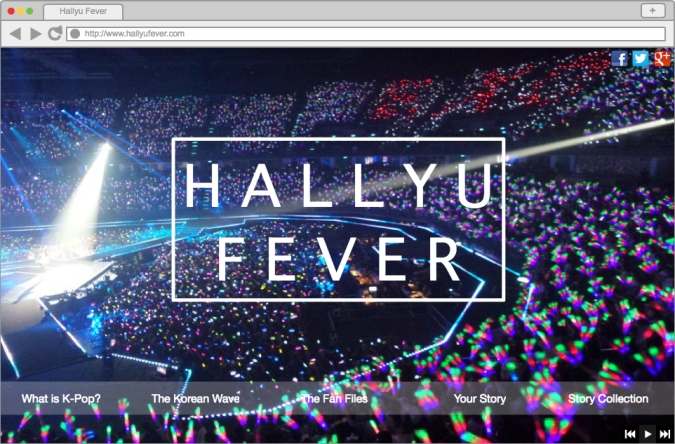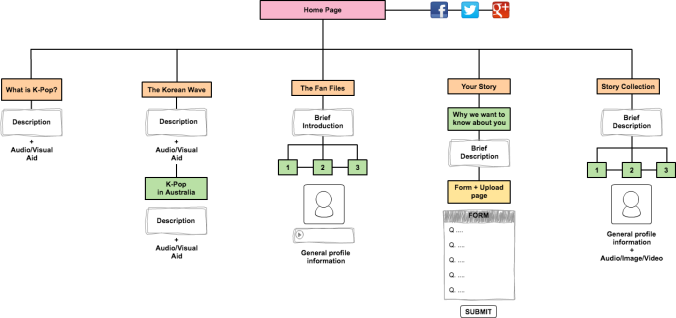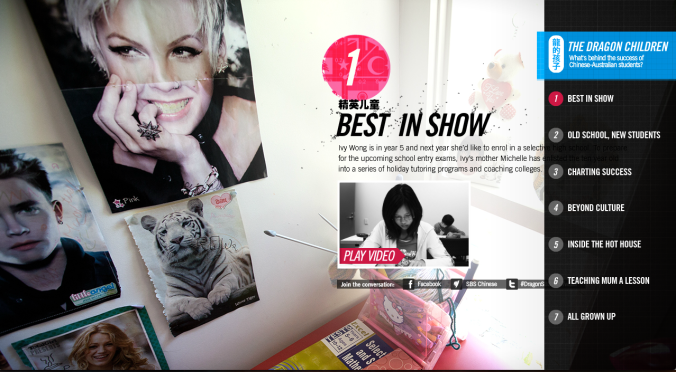
A mock-up of Hallyu Fever‘s home page
TITLE
Hallyu Fever
BACKGROUND
Thinking about Assessment 2, I was lost about what I wanted to do as a topic for a potential online documentary. I thought about what I was interested in and that was a struggle because I was interested in a lot of things. In the end, I narrowed it down to a few ideas and eventually came to a single topic: South Korean pop music.
In my online documentary, I am interested in South Korean pop music (better known as K-Pop). K-Pop can be described as a dance-pop genre that is based on the combination of the traditional Korean style melody and Western music patterns (Lee 2013, p.85). Although I am a fan of K-Pop myself, the actual motivation and inspiration was my best friend who has become a new (and obsessed) fan. In the past month or so, she would message and ‘fan-girl’ to me about all the amazing music and videos that she’d come across. She was incredulous about how she did not find out about it sooner. For me, it was fascinating to see and watch her quickly become immersed in a genre of music from a foreign culture so different from her own.
But how have people, especially from abroad, become so interested in Korean pop music? In recent years, South Korean pop music has become a global phenomenon. It has become tremendously popular in different countries throughout Asia, Europe, the U.S and the Middle East (Lie 2012, p.340). The success of K-Pop is largely attributed to the proliferation of digital media and communication technologies, particularly the Internet and YouTube. It has enabled international audiences to access diverse media content that is not accessible in their own country (Lee 2013, p.174).
Even though the Internet and YouTube may be considered the ‘gateway’ for many K-Pop fans, I believe that individuals will have unique experiences in how they have come to deeply admire and feel attached to the genre and culture. In order to gain further insight, Hallyu Fever will an interactive exploration into K-Pop and the globalisation of South Korean pop culture, particularly in Australia, and identify how K-Pop has shaped their identity and way of life as an Australian fan. In effect, they develop their own diverse thoughts, feelings and habits. Through interviews and fan stories, Hallyu Fever aims to explore and identify how K-Pop has shaped their identity and way of life as an Australian fan. Potentially, it could be considered as digital media platform that is contributing to the rise of K-Pop subculture by connecting individuals with others fans and creating a community.
The rising subculture of K-Pop fandom in Australia is demonstrated through this Channel 7 Sunrise segment from 2011:
AUDIENCE
The primary target audience would be fans of Korean pop music or those who are generally interested in foreign music. However, Hallyu Fever can also be an informative source on K-Pop and fandom to those who are unaware of the Korean Wave (also known as the Hallyu Wave). More specifically, the online documentary will be available on a web-based platform. Therefore, Hallyu Fever will most likely be geared towards a target demographic of teenagers and young adults who have greater access to desktop devices, are accustomed to web-browsing and have the highest Internet consumption.
PLATFORM
Hallyu Fever will be delivered in a digital format as a desktop web experience. Therefore, users will be able to access the online documentary on desktop computers, laptops and tablet Internet browsers such as Safari and Chrome.
USER EXPERIENCE + SITE MAP
Hallyu Fever will be an interactive experience where users are able to participate and contribute to the online documentary through the submission of their own personal experiences as K-Pop fans. Also, it is a non-linear online documentary because a story or narrative does not exist meaning it does not have a clear beginning and end. Therefore, the user will have the freedom to navigate through the online documentary as they wish.

As shown above, I have developed a site map for Hallyu Fever based on the hierarchic structure. The hierarchic structure has helped to define a clear order and level of each idea I have developed, moving from the general to the more specific.
As shown above, the main topics that I have planned to discuss and explore are:
- What is K-Pop?
- The Korean Wave
- The Fan Files
- Your Story
- Story Collection
In developing my structure, I opted to create a simple hierarchic structure with 2 to 3 levels. If I were to add more, there was a risk of overwhelming or boring users with too much content or paths.
CONTENT STRUCTURE
What is K-Pop?
In this section, the user will be informed on the characteristics of modern South Korean pop music. In Korean, the term ‘yangak’ is used to describe K-Pop as a ‘Western-style’ form of music genre. It will be helpful for users who have never heard of or do not know the composition of South Korean pop music. Also, I will discuss the influences of traditional and foreign music styles and genres on developing the modern South Korean sound. I will insert audio and visual aid for users to see, hear and understand the sound of modern K-Pop. It could include a playlist of K-Pop songs, music videos and/or performance clips. It is possible that users will be able to juxtapose and contrast the differences in the sound, style and performance between K-Pop and mainstream Western pop music.
The Korean Wave
The ‘Korean Wave’ section will focus on the globalisation of South Korean pop culture, dubbed the ‘Korean Wave’ or the ‘Hallyu Wave’. The phrase ‘Korean Wave’ has been adopted to describe the rise of South Korean pop culture in the late 1990s. The user will be provided a brief description about the contribution of K-Pop and significant feats achieved by Korean artists in the mainstream Western music industry, as well as navigate through a few of the most popular K-Pop songs, music videos and/or performance clips. To further narrow down the scope, the section will lead into another page: K-Pop in Australia. It will focus more on the influence of South Korean pop music on Australia. In particular, I will be noting the impact that K-Pop has had on Australian music and media including SBS Australia’s PopAsia (television and radio broadcast),Q-Pop (A K-Pop inspired tourism campaign for Queensland) and concerts (including 2011 Sydney K-Pop Festival).
The Fan Files
This section comprises of all the profiles collected from interviews for Hallyu Fever. It will include general profile information, photographs and audio clips from the interviews that I have undertaken. The user will be able to interact with content, learning more about how and why people have become so immersed in an aspect of a foreign culture that is so different from their own. In particular, the user will be able to listen to the interviews of certain individuals and hear the different thoughts and feeling that they have about how it has influenced their lives, why they enjoy listening to the music and what they think makes it so special. Each individual person will have his or her own unique story, providing a diverse range of perspectives about the topic.
It will contain a profile picture and general information about interview participants will be in the form of this layout:
- First Name
- Age
- How long they have been a fan of K-Pop
During the interview, I would like to focus on a few particular questions.
- How did you find out about K-Pop?
- What drew you to K-Pop?
- What made you become a fan?
- Who is K-Pop idol/group bias (favourite)?
- What is your favourite part of being a K-Pop fan?
- What are the pros and cons of being an International fan?
- Why makes K-Pop unique in comparison to mainstream Western music?
After speaking to a few K-Pop fans as potential participants, they were more comfortable providing an audio interview rather than a video interview. At the moment, three people have already agreed to be interviewed for my project. Depending on whether the idea is chosen, I am willing and able to find more participants to interview if necessary. If comfortable, interview participants are also encouraged to provide their own images demonstrating their obsession such as fan goods/collections, fan art or concert photos.
Your Story
The ‘Your Story’ section focuses on user contribution and interactivity. In this section, users are encouraged to submit a form about their own experiences as a K-Pop fan and their perspectives on the globalised nature of South Korean pop music. My first idea was to create a page where users could fill out a form in a question and answer layout that was similar to what I will ask the interview participants in the ‘Fan Files’ section and upload their own media content such as image, audio and/or video. Individuals can attach their selfie pictures or K-Pop related images and videos if they wish. If it is easier, I can change the question and answer layout into a free-text box where people can reveal their experiences in their own personal style and manner. All submissions will be placed in another section called the ‘Story Collection’.
INTERFACE DESIGN
The ideal interface of Hallyu Fever is bright and colourful, inspired by the fun and eccentric nature of K-Pop music, style and performance. However, I would like to maintain a minimal and aesthetic design to avoid clutter and information overload that could potentially disengage the audience.

A section of SBS Australia’s The Dragon Children
In Hallyu Fever, two menus will be provided. The user will be able to choose their topic of interest on the main menu placed on the bottom of the home page. The interface aims to be intuitive as it allows users to become familiar with the layout and structure. If possible, I would like to recreate a similar sidebar menu that was used in SBS Australia’s The Dragon Children. Once users select a particular section, numbered icons representing the sidebar menu will appear using hover controls. The function is highly aesthetic and intuitive, allowing users to find and view content with ease, as well as maintaining a clean interface. The use of vivid colours will help create distinction in order to differentiate between sections and pages, as well as helping to attract and direct the user’s attention towards instruction (Fadeyev 2009, p.13).

The home page of KpopUnited
For the home page, I was inspired by the website KpopUnited. The home page of KpopUnited uses moving imagery in the form of looped videos of K-Pop idols, performances, concerts and fans. The content fills most of the screen, employing negative space above in the main menu bar. For Hallyu Fever, I could utilise the same concept or go for something a bit different such as a slideshow or a montage of different images.
Similar to KpopUnited and The Dragon Children, I want to fill the background of the different sections and pages with rich imagery that is relevant to the topic that has been selected. As I would like to keep the interface rather clean, I would like to keep most descriptions relatively brief. However, I plan to have a fair bit of written content presented on Hallyu Fever. In The Dragon Children, there is no use of negative space because the text is placed directly onto the background image. It is an issue for heavier pieces of text because reading will cause strain and difficulty on the user. As a result, it may negatively impact the user experience.
The employment of negative space in text boxes will help to prevent such an issue. If there is too much information, the text boxes will include pages and arrows as a directory guide. Also, I will provide users with hyperlinks that will lead users towards more helpful information if they are interested.
In the background, there will be a playlist of K-Pop instrumental music placed on the bottom right section of the screen. It will help to promote an upbeat and positive atmosphere for the user’s enjoyment. If it creates the opposite effect, the user is able to mute the playlist.
SOCIAL MEDIA
In my site map, social media has been integrated into my online documentary. I have used website icons allowing users to be able to connect and share the website to their respective Facebook, Twitter or Google+ accounts. For Hallyu Fever, Facebook and Instagram would be the most appropriate social media platforms as a source of updates and staying connected with users. It will help to maintain relevance and engagement with the target audience. If the user has viewed, participated in or contributed to the online documentary, it is likely that they would like to share their experience and connect with others. As a result, it will help to increase visibility and generate more traffic and exposure for the online documentary.
FEASIBILITY
In the timeframe given, I believe that the project is feasible and achievable. Although I am not familiar with editing software, I do not believe there is anything that is very technical or difficult in what I have proposed for Hallyu Fever.
In terms of content, I have chosen to conduct interviews with several individuals who are fans of K-Pop. It will not be difficult to gather participants and undertake interviews because I have already sought people who have agreed to be a subject for the project and share their experiences. In addition, I know them very well and have personal contact with them so it will not be difficult to sort dates and times in the upcoming weeks.
As the interviews will be recorded as audio files, there won’t be too many issues with hardware and devices. I plan to undertake the interviews with my Samsung Galaxy S6 smartphone using a voice recording application because I believe it does the job in a simple and straightforward manner. However, there is a risk of background noise that will interfere with the clarity of the audio. The setting and equipment are things that will be considered and kept in mind as I prepare for the interviews.
REFERENCES
Fadeyev, D. 2009, ‘User interface design in modern web application’ in
V. Friedman & S. Lennartz, The Smashing Book, Smashing Media, Lubeck, Germany, pp. 9-27
Lee, GT, 2013, De-Nationalization and Re-Nationalization of Culture: The Globalization of K-Pop, Dissertation, Seoul National University, viewed 26 May 2016 <http://digilib.gmu.edu/jspui/bitstream/1920/8228/1/Lee_gmu_0883E_10307.pdf
Lie, J 2012, What is the K in K-Pop? South Korean Popular Music, the Culture Industry, and National Identity, Korean Observer, 43, No. 3, p. 339-363